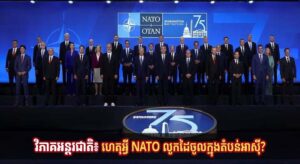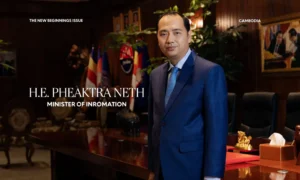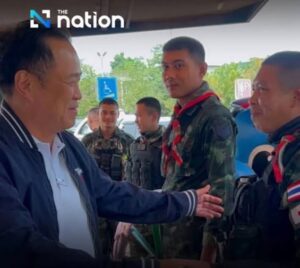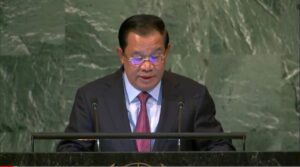Remarks by Samdech Techo Hun Sen at the 25th World Knowledge Forum under the Topic: The Road to Coexistence and Prosperity in ASEAN
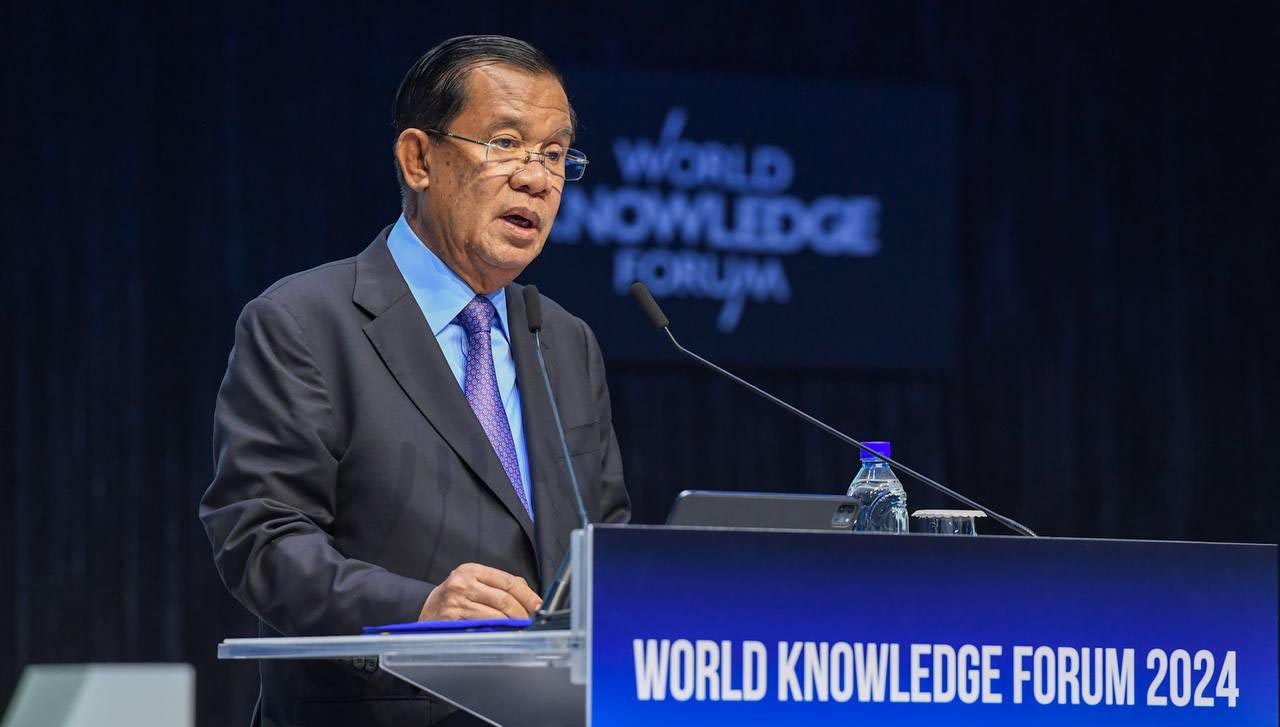 Remarks by Samdech Techo Hun Sen at the 25th World Knowledge Forum under the Topic: The Road to Coexistence and Prosperity in ASEAN
Remarks by Samdech Techo Hun Sen at the 25th World Knowledge Forum under the Topic: The Road to Coexistence and Prosperity in ASEAN
CNV: 10/09/2024
Dr. CHANG Dae-whan, Chairman of the Maekyung Media Group and Founder of the World Knowledge Forum,
Excellencies, Ladies and Gentlemen!
First and foremost, I would like to extend my congratulations to the World Knowledge Forum on its 25th anniversary under the wise leadership of the founder, Dr. CHANG Dae-whan. This forum always brings together leaders from public sector, private sector, academia, and science to discuss emerging issues and challenges that impact global governance in the context of peace and sustainable development. Today, I have great pleasure to share my perspective at this august forum on the topic “The Road to Coexistence and Prosperity in ASEAN”, which I think is critical as the world faces growing trends of fragmentation, division, discrimination, and disregard for multilateralism and other multiple challenges that may impact peace, security, and cause disruption for sustainable development.
Cambodia recognized ASEAN as a regional multilateral mechanism that operates on consensus and non-interference in the internal affairs of its member state, and is also a regional institution with many cooperation partners. These factors were very attractive for Cambodia’s foreign policy as we want to promote the protection of peace and sovereignty, while at the same time wish to seek a wider gateway to the world for international cooperation and Cambodia’s economic development.
With this perspective in mind, I personally led Cambodia to join ASEAN in 1999. Three years later, Cambodia volunteered to take over the rotating chairmanship of ASEAN despite facing numerous challenges in terms of resources and institutional capacity. Under my leadership, Cambodia has held the rotating chairmanship of ASEAN three times.
Today, I would like to share some insights into ASEAN’s enduring efforts to promote peace and prosperity in the region that has faced countless challenges over the past six decades.
I will divide my deliberation into two key parts.
Part 1: Peaceful Coexistence. The key question is what formula that ASEAN employs to maintain and promote peaceful coexistence?
Over nearly 60 years since its inception, many predicted that ASEAN would not succeed due to the significant differences between member states in terms of political systems, economies, ethnicities, cultures, and languages. However, ASEAN has not weakened, instead it has been growing stronger, with many nations seeking partnerships and engagements with ASEAN, wanting to utilize the regular ASEAN-led platforms as they all recognize ASEAN’s relevance, ASEAN Centrality, and its convening power, which has the ability to gather key global players. In fact, as of today, 54 countries have become parties to the Treaty of Amity and Cooperation in Southeast Asia (TAC), and 95 non-ASEAN member states ambassadors to ASEAN (NAAAs) has been accredited.
Peaceful coexistence, both within ASEAN and with external partners, has been possible because ASEAN consistently adheres to key principles enshrined in the ASEAN Charter, many of which are also reflected in the UN Charter.
Within ASEAN, we maintain strong internal unity through two key principles: decision-making by consensus and non-interference in internal affairs. The consensus is to ensure that all member states, regardless of size or wealth, have equal rights, and can contribute to building a community that serves everyone. The principle of non-interference allows each member state to choose its own path for national development according to its specific needs and circumstances.
With external actors, ASEAN’s core principles include neutrality, peaceful resolution of conflicts, dialogue, and cooperation, with the focus on building friendships and partnerships with all parties. ASEAN has not favored one party over others, but instead, has become a reliable and trustworthy partner to all, both within and outside the region. As a result of these principles, many countries have proposed to join the Treaty of Amity and Cooperation in Southeast Asia (TAC), and the existing partners have consistently aimed to upgrade their cooperation to be more comprehensive and strategic.
ASEAN always places significant emphasis on reinforcing its centrality and ASEAN-led mechanisms have enabled our regional organization to convene, particularly the East Asia Summit and the ASEAN Regional Forum, with the participation of leaders from many partner countries, including major global powers to exchange views and seek solutions to regional and global challenges. Furthermore, these mechanisms have contributed significantly in reducing tensions, distrust, and mitigating differences among key players that could jeopardize overall peace and security.
For ASEAN, peace and stability are the foundations of everything. ASEAN has consistently been proactive in advancing the peace agenda. For instance, Cambodia’s peace negotiations received significant contributions from ASEAN member states such as Indonesia and Thailand, even before Cambodia officially joined ASEAN. When Myanmar faces internal challenges and insecurities that could destabilize the region and trigger a transnational humanitarian crisis, ASEAN has its own mechanisms in place to help Myanmar return to normalcy while respecting the ownership of Myanmar over its domestic politics. Even during times of intense disagreement, nations in conflict can leverage ASEAN platforms to express their positions and promote mutual understanding through dialogue. ASEAN has always supported dialogue and cooperation to build mutual trust, but ASEAN does not support the mobilization of unity for confrontation against any party. In fact, ASEAN has not created a military alliance between its member states or with any superpower to compete against any other superpowers.
ASEAN’s active role in maintaining peace and stability, its sincere commitment to upholding international order based on the principles of international law, adhering to the principles of multilateralism, and neutrality, and its promotion of dialogue and consultation to resolve challenges and differences, are all key fundamentals that inspire confidence of partner countries in ASEAN; and these factors encourage them to use ASEAN platforms to effectively engage in promoting security and regional and global challenges through ASEAN-led multilateral mechanisms.
Now, I would like to move on to Part 2: Fostering Prosperity.
When ASEAN was initially established in 1967, most all its member states were newly independent from colonial rule. When ASEAN later expanded its membership to include Cambodia, Laos PDR, Myanmar, and Vietnam, some pessimistic views suggested that integrating these members would slow down ASEAN’s economic progress and integration. However, in reality, ASEAN’s overall economy, trade between ASEAN and its partners, and foreign investment into ASEAN have steadily grown year after year, despite occasional global economic downturns. From a region that struggled to catch up the development to a region that can drive regional and global economic growth, ASEAN has become the world’s fifth-largest economic power, with a GDP exceeding USD 3 trillion, a substantial purchasing power with a market of over 650 million people, an industrial manufacturing hub, an interconnected production power and supply chain, and an extensive trade network around the world.
ASEAN has prioritized economic integration, particularly through the establishment of free trade agreements with various partners such as the Republic of Korea, China, Japan, Australia, New Zealand, India, Hong Kong, as well as the Regional Comprehensive Economic Partnership (RCEP). As a country benefiting from these integrations, Cambodia consistently supports a free, open, inclusive, fair, and transparent multilateral trade system with the World Trade Organization at its core.
ASEAN has continued to explore new sources of growth, such as the digital economy, green transitions, enhanced regional supply chains, connectivity, science, technology, and innovation, which will enable our region to achieve not only high economic growth, but also resilience and sustainability. All of these priorities are clearly outlined in the ASEAN Community Vision 2045 as well as in the strategic plans of the three pillars of the ASEAN Community.
ASEAN adheres to the principles of inclusivity in building its community, focusing on a people-centered approach, with the vision of leaving no place and no one behind. Therefore, in addition to prioritizing regional prosperity, ASEAN strives to narrow the development gaps within and among member states, including through the implementation of the Initiatives for ASEAN Integration.
Excellencies, Ladies and Gentlemen!
I hope my presentation above provides valuable insights to the public on the international forum to better understand ASEAN, its achievements, and mechanisms, which are rooted in regional peace and stability as a foundation for promoting integration and prosperity for the people of the region.
Finally, I wish the World Knowledge Forum great success, and I extend my best wishes to His Excellencies, Ladies, and Gentlemen for good health, happiness, prosperity, and success in all your endeavors.
Thank You!


